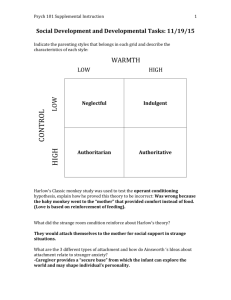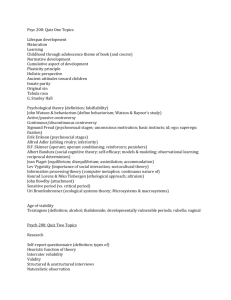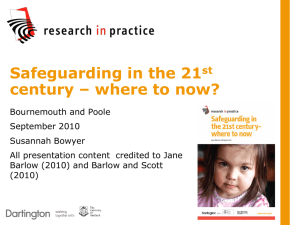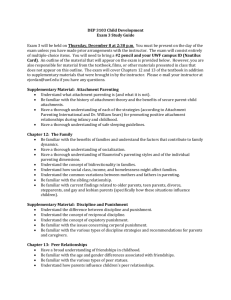CHAPTER 1 – INTRODUCTION TO PSYCHOLOGY AND METHODS
advertisement
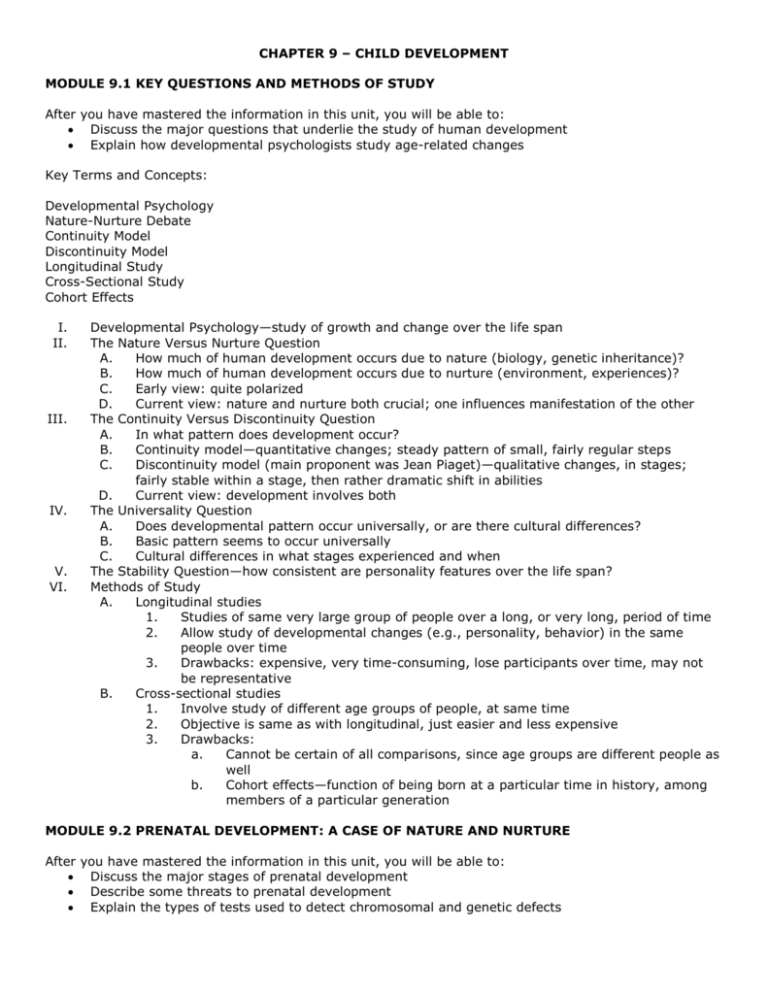
CHAPTER 9 – CHILD DEVELOPMENT MODULE 9.1 KEY QUESTIONS AND METHODS OF STUDY After you have mastered the information in this unit, you will be able to: Discuss the major questions that underlie the study of human development Explain how developmental psychologists study age-related changes Key Terms and Concepts: Developmental Psychology Nature-Nurture Debate Continuity Model Discontinuity Model Longitudinal Study Cross-Sectional Study Cohort Effects I. II. III. IV. V. VI. Developmental Psychology—study of growth and change over the life span The Nature Versus Nurture Question A. How much of human development occurs due to nature (biology, genetic inheritance)? B. How much of human development occurs due to nurture (environment, experiences)? C. Early view: quite polarized D. Current view: nature and nurture both crucial; one influences manifestation of the other The Continuity Versus Discontinuity Question A. In what pattern does development occur? B. Continuity model—quantitative changes; steady pattern of small, fairly regular steps C. Discontinuity model (main proponent was Jean Piaget)—qualitative changes, in stages; fairly stable within a stage, then rather dramatic shift in abilities D. Current view: development involves both The Universality Question A. Does developmental pattern occur universally, or are there cultural differences? B. Basic pattern seems to occur universally C. Cultural differences in what stages experienced and when The Stability Question—how consistent are personality features over the life span? Methods of Study A. Longitudinal studies 1. Studies of same very large group of people over a long, or very long, period of time 2. Allow study of developmental changes (e.g., personality, behavior) in the same people over time 3. Drawbacks: expensive, very time-consuming, lose participants over time, may not be representative B. Cross-sectional studies 1. Involve study of different age groups of people, at same time 2. Objective is same as with longitudinal, just easier and less expensive 3. Drawbacks: a. Cannot be certain of all comparisons, since age groups are different people as well b. Cohort effects—function of being born at a particular time in history, among members of a particular generation MODULE 9.2 PRENATAL DEVELOPMENT: A CASE OF NATURE AND NURTURE After you have mastered the information in this unit, you will be able to: Discuss the major stages of prenatal development Describe some threats to prenatal development Explain the types of tests used to detect chromosomal and genetic defects Key Terms and Concepts: Ovum Ovulation Fallopian Tube Zygote Germinal Stage Fertilization Uterus Embryonic Stage Embryo Neural Tube Amniotic Sac Placenta Fetal Stage Fetus Spina Bifida Teratogen Rebulla Sudden Infant Death Syndrome (SIDS) Fetal Alcohol Syndrome (FAS) Amniocentesis Chorionic Villus Sampling (CVS) Chorion Down Syndrome Ultrasound Imaging I. II. III. Stages of Pregnancy (about 280 days total) A. Germinal 1. Approximately the first two weeks after conception 2. Spans from moment of fertilization to complete implantation within the uterine lining B. Embryonic (organism is an embryo) 1. Period from two weeks to eight weeks after conception 2. Basics of major organ systems develop 3. Baby is cushioned by amniotic fluid; nutrients, oxygen and wastes are exchanged via placenta C. Fetal—from ninthweek of pregnancy until birth (organism is a fetus) Threats to Prenatal Development A. Adequate nutrition important, including sufficient folic acid (reduces risk of neural tube defects if taken during and preferably before first trimester of pregnancy) B. Teratogens (cause harm to developing baby) 1. Infectious diseases a. Rubella (German measles)—can cause heart disease, deafness, mental retardation b. Sexually transmitted diseases (HIV, syphilis) 2. Smoking—increases risk for miscarriage, premature birth, low birth weight, infant mortality, SIDS, respiratory problems, hyperactivity 3. Alcohol and drugs—increase risk of birth defects, infant mortality, mental retardation Prenatal Testing (testing for fetal abnormalities) A. Amniocentesis—extract amniotic fluid (which contains fetal cells) B. Chorionic villus sampling (CVS)—chorion membrane tissue is analyzed C. Ultrasound imaging—gives picture of fetus and amniotic sac D. Parental blood tests—detects if parents are carriers of genetic disorders MODULE 9.3 INFANT DEVELOPMENT After you have mastered the information in this unit, you will be able to: Describe the reflexes that newborn babies show Outline infant physical development during the first year of life Discuss the abilities infants possess with respect to sensory functioning, perception, and learning Explain how the infant' motor abilities develop during the first year Key Terms and Concepts: Rooting Reflex Eyeblink Reflex Sucking Reflex Moro Reflex Palmar Grasp Reflex Babinski Reflex Maturation I. II. III. IV. Reflexes—unlearned, automatic responses to stimuli (usually have survival value; most disappear after a few months) A. Rooting reflex—turn head in direction of stroke to cheek B. Eyeblink reflex—protects from bright light, foreign objects C. Sucking reflex—enables baby to get nourishment D. Moro reflex (startle reflex)—response to being frightened (e.g., loud noise) E. Palmar grasp reflex—curling fingers tightly around an object F. Babinski reflex—toes fan out and curl when sole of foot stroked Physical Development and Brain Size A. Maturation—underlying blueprint directing much of emerging characteristics, patterns of growth B. Role of environment—better nutrition has produced larger infants, children C. Weight usually triples during first year D. Brain quadruples in volume from birth to adulthood 1. Most of neurons in brain formed before birth 2. Increase in volume is due to a. Creation of synapses (neural interconnections) b. Formation of myelin sheath covering axons (allows for quicker, more efficient neural communication) Sensory, Perceptual, and Learning Abilities in Infancy A. Sensory ability 1. Vision a. Least well-developed sense b. Can recognize (and prefer) mother’s face; track moving objects 2. Depth perception a. Studied using visual cliff apparatus b. Depth perception apparent by age of six months 3. Hearing a. Well developed at birth; know and prefer mother’s voice b. Babies especially responsive to sounds corresponding to range of human verbal expression c. By three months of age can distinguish among some speech sounds 4. Odors and tastes—newborns can differentiate among both, show preferences B. Perceptual ability 1. Infants born with many perceptual abilities 2. Can differentiate among meaningful stimuli shortly after birth 3. Show a preference for faces among visual stimuli 4. Differentiate among facial expressions by four to six months of age C. Learning ability 1. Can learn some simple (e.g., operantly conditioned) responses 2. Retain this learning for at least several weeks 3. Show prenatal learning in preference for mother’s voice Motor Development A. Many universal features in pattern of development B. Goal-directed behaviors evidenced early on (e.g., bringing fist to mouth) C. Early reflexive behavior slowly replaced by intentional, voluntary movements D. Sitting alone, standing, and walking usually mastered by one year of age MODULE 9.4 EMOTIONAL AND SOCIAL DEVELOPMENT After you have mastered the information in this unit, you will be able to: Compare and contrast the three basic types of infant temperament identified in the New York Longitudinal Study Describe the three types of attachment styles identified by Ainsworth Compare and contrast the three major styles of parenting in Baumrind' model Explain the roles that peer relationships play in children' emotional and social development Outline Erikson' childhood stages of psychosocial development Key Terms and Concepts: Temperament Attachment Bonding Imprinting Strange Situation Internal Working Model I. II. Temperament A. More variation in social and emotional development (in comparison to development of physical abilities) B. Types of temperament (based on New York Longitudinal Study [NYLS]) 1. Easy children—40 percent of children in study; playful, adaptive 2. Difficult children—10 percent of children in study; negative, irritable 3. Slow-to-warm-up children—15 percent of children in study; “inhibited,” need more time to adjust 4. 35 percent of children in study could not be classified C. Temperament in childhood predicts adjustment as an adult D. Both nature and nurture are influences E. Children can learn to adapt successfully to environment, regardless of temperament Attachment—enduring emotional bond, develops over time A. Attachment behaviors in other species 1. Attachment found in many other species 2. Konrad Lorenz—studied ducks, geese, other fowl 3. Imprinting—following behavior; occurs in response to first moving object seen (shortly after birth) 4. Harry and Marguerite Harlow—rhesus monkeys prefer soft, cuddly surrogate “mother,” even when other surrogate has food B. Attachment in human infants 1. John Bowlby (1908-1990) a. Attachment biologically based, necessary for survival b. Quality of attachment related to sensitivity, degree of care from parent 2. Mary Ainsworth—developed methodology to assess attachment (Strange Situation) and identified three basic types a. Secure attachment (Type B)—65 to 70 percent of children show; rely on parent, warm reunion when mother returns b. Insecure-avoidant attachment (Type A)—about 20 percent of children show; child has little interest, little distress with regard to parent c. Insecure-resistant attachment (Type C)—about 10 percent of children show; emotionally erratic, ambivalent or may rebuff mother d. Fourth type of attachment identified later—disorganized/disoriented (Type D)—child seems confused, unable to make effective use of available support, unable to approach parent directly even when in need e. Conclusion: responding promptly, appropriately to infant’s signals leads to secure attachment 3. Criticisms of Strange Situation research method III. IV. V. a. Attachment measured in too limited a period b. Method may not take cultural differences into account C. Attachment and later development 1. Early attachment styles affect later emotional relationships 2. Poor adult attachment patterns correlated with poorer physical and emotional health 3. Early attachment experiences result in internal working models—expectations for what emotional relationships are like 4. More securely attached infant more likely to later exhibit: better adjustment, higher self-esteem, greater cooperativeness, greater independence, fewer behavioral problems, better peer relationships, better overall emotional health Child-Rearing Influences A. Characteristics of good parenting 1. Many factors influence child’s emotional, intellectual, and social development 2. Factors include genetics, peer groups, quality of parenting 3. Quality parenting: spending much time with children; sensitive to their needs and cues; modeling and reinforcing appropriate behaviors; setting and explaining clear rules, establishing limits; consistency in standards and interaction; providing warm, loving environment B. Father’s influence 1. Involved fathers have children who perform better academically 2. Two-parent (mother, father) families have children with greater academic and social success 3. Fathers (in western societies) engage in more active physical play with children, less basic care giving, relative to mothers C. Cultural differences in parenting 1. African American a. Strong kinship bonds; parenting is shared among family members b. Grandmother may assume most important role 2. Hispanic a. Father is traditional provider, protector b. Mother usually assumes full child-care responsibility c. Fairly strict discipline standards; emphasis on demeanor, respect towards adults d. Currently changing as cultural characteristics change 3. Asian cultures a. Emphasize respect for parental authority, particularly that of father b. Usually warm relationship with mother 4. All cultures move child from dependency to independence D. Parenting styles (Baumrind, 1971, 1991) 1. Three basic types of parenting styles identified a. Authoritative—reasonable, consistent limits; loving; listen; explain b. Authoritarian—rigid, demand unquestioning obedience; disregard for child’s feelings or point of view c. Permissive—little involvement on part of parent as far as establishing guidelines, rules; little follow-through 2. Critique a. Need to consider environment when evaluating effectiveness of parenting style (e.g., high-risk may necessitate different parenting tactics in comparison to low-risk environment) b. Cultural influences may vary with regard to what are considered desirable parenting qualities c. Some influence from child’s personality Peer Relationships A. Peer relationships affect much of child’s development B. Provide opportunities to develop social competencies, self-esteem, emotional understanding C. Peer-rejected children are at greater risk (lower academic performance, poorer social and psychological adjustment) D. Some peer influence undesirable (e.g., learning deviant behaviors) Erikson’s Stages of Psychosocial Development A. B. C. VI. Emphasized importance of social relationships (1963) Personalities shaped by psychosocial challenges Stages that cover childhood development period: 1. Trust vs. mistrust a. First year of life—creates view of people, world in general b. Trust develops when infant treated with warmth, responsiveness c. Mistrust develops when child not attended to 2. Autonomy vs. shame and doubt a. One through three years of age b. Child’s greater mobility, inquisitiveness, toilet training are major features c. Shame and doubt if child criticized, given tasks beyond his abilities 3. Initiative vs. guilt a. Includes child’s ages of four and five years b. Children come up with own ideas, not just adopting those of others c. When praised, gain sense of confidence, competence d. When criticized, feel inept, incapable, awkward 4. Industry vs. inferiority a. Includes elementary school ages (approximately six to twelve years) b. Not only initiate own tasks, interests, but much more likely to follow them through c. Very many skills and areas of knowledge gained (academic, social, physical/motor) d. Much comparison by children among themselves, in addition to feedback from parents, teachers D. Experiences later in life can alter impact of earlier stages Exploring Psychology: Does Day Care Affect Attachment? A. More preschoolers now in day-care centers than at home, or in relative’s home B. Apparently no differences in attachment patterns for children experiencing full-time daycare setting C. High-quality care can have positive effects on cognitive and social development D. Possibly long hours of day care associated with more aggressiveness E. Effects on child development related to quality of care, whether day-care setting or at home 1. Parents should ask about licensure; facilities; policies; staff attitudes, morale, and qualifications; types of toys/activities available to children MODULE 9.5 COGNITIVE DEVELOPMENT After you have mastered the information in this unit, you will be able to: Compare and contrast assimilation and accommodation Describe Piaget' stages of cognitive development Discuss the basic theme in Vygotsky' theory of cognitive development Key Terms and Concepts: Schema Adaptation Assimilation Accommodation Object Permanence Symbolic Representations Egocentrism Animistic Thinking Irreversibility Centration Conservation Formal Operations Zone of Proximal Development Scaffolding I. Piaget’s Theory of Cognitive Development A. Basics of Piaget’s theory 1. 2. 3. 4. 5. II. Best way to learn about children is to observe them carefully Schema—organizational system used by individuals to interact with the world Adaptation—changing in order to better meet challenges in the world Assimilation—adding a new item to an existing schema Accommodation—modifying an existing schema (or creating a new one) to account for phenomena that do not fit in existing schemas 6. Stage approach to cognitive development a. Assimilation and accommodation processes are lifelong b. Cognitive development progresses through stages—universal pattern for all children; each stage qualitatively different from others B. Sensorimotor stage 1. Birth to two years of age 2. Gain object permanence (traditional test) by about eight months of age 3. Learn about world through motor actions; sensory system detects result C. Preoperational stage 1. Two to seven years of age 2. Still do not have logical cognitive ability 3. Gain ability for symbolic representations (one is language) 4. Piaget’s view—child egocentric until end of stage; uses animistic thinking 5. Do not yet understand principles of conservation (of number, area, volume) D. Concrete operational stage 1. Seven to eleven years of age 2. Gain understanding of conservation—when nothing added or subtracted, quantity does not change though form or appearance might 3. Can perform simple logical operations provided they deal with real-world examples (e.g., do not involve abstract or hypothetical thinking) E. Formal operational stage 1. Last stage—begins at about eleven or twelve years of age 2. Full cognitive maturity—but not everyone reaches this level 3. Can manage deductive, abstract, and hypothetical thinking F. Critique of Piaget’s theory 1. Challenges to the stage model of development a. Another view is that development is quantitative and continuous 2. Underestimation of children’s abilities a. More recent research—children more capable, earlier than Piaget realized b. Tasks may be too difficult to show what children know 3. Lack of attention to cultural influences on cognitive development a. Cross-cultural studies confirm order of stages of development, not timing Vygotsky’s Sociocultural Theory of Cognitive Development A. A Russian psychologist (1896−1934); social interactions are vehicle for learning B. Zone of proximal development—what child can learn, with guidance, help C. Scaffolding—scale instruction to level of child; adjust as child progresses MODULE 9.6 APPLICATION: TV AND KIDS After you have mastered the information in this unit, you will be able to: Explain how TV viewing influences children' development I. Possible Physical and Psychological Drawbacks to Children’s Viewing Television A. Television takes away from other important activities—keep in mind that children are not always engaged in “constructive” activities B. It is because of television that children do poorly in school—there is a slight but consistent negative correlation between television viewing and performance in school (e.g., as hours of television viewing increase among children, academic achievement decreases) C. Watching television fosters violence and aggressive behavior in children 1. Even children’s programs have much violent content 2. Heroes often win with violence—sends the message that violence is acceptable 3. Violence on television increases aggressive behavior; aggressive individuals select more violent programming 4. II. Research by Albert Bandura—children exhibit more aggressive behavior when they see it modeled 5. Habituation effects—viewers become sensitized to real-life violence D. TV viewing is related to obesity in children Parent’s Role in Responsible Television Viewing for Children A. Screen programs children will watch B. Join child in television viewing, explain C. Avoid using television as a baby-sitter D. Limit hours of TV viewing (recommended is one to two hours a day at most) E. Encourage children to limit viewing, choose programs wisely F. News programs may be very inappropriate for young children G. Avoid eating in front of the television (for anyone) H. Encourage other interests on the part of the child

